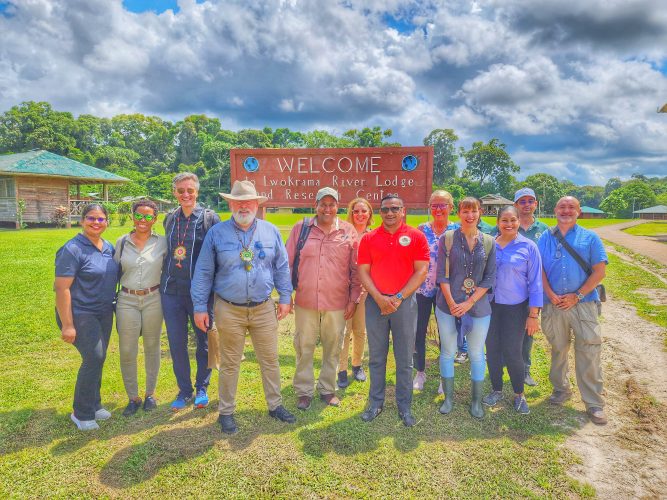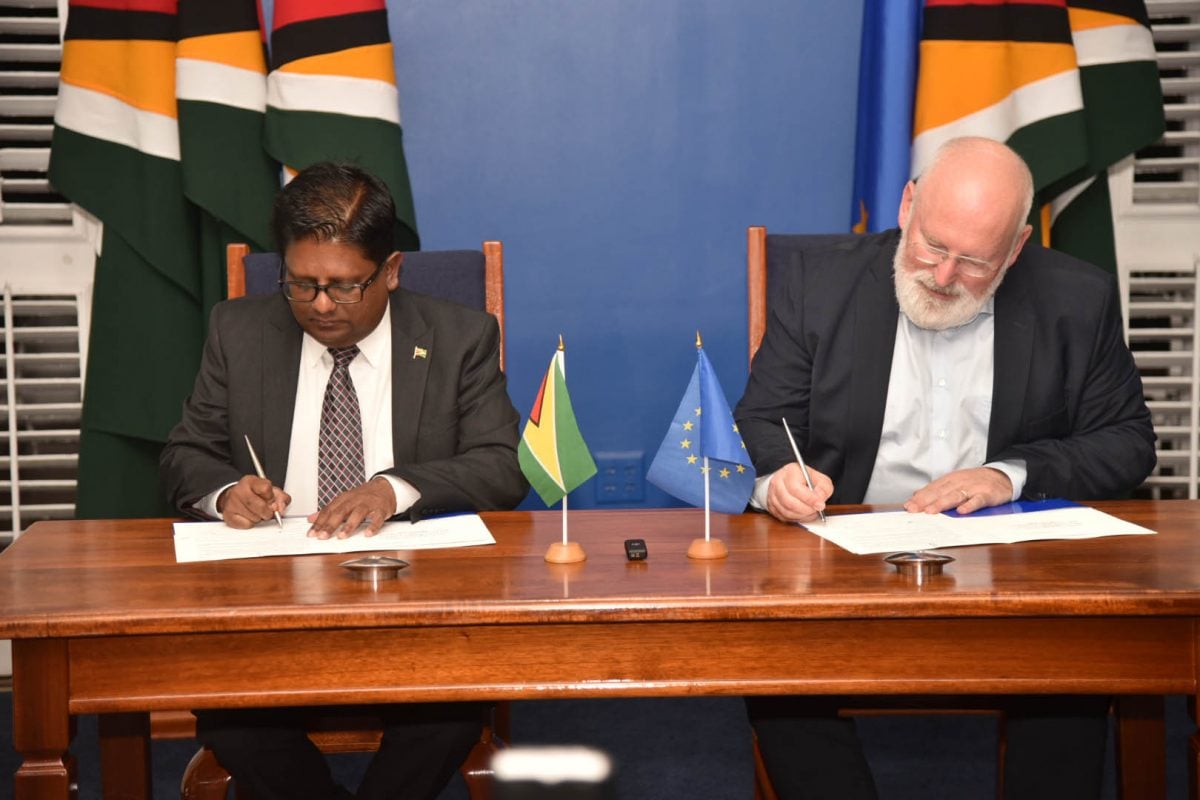A European Union (EU) agreement with Guyana for the advancement and expansion of mangroves will see the country receiving budgetary support to the tune of €4.6 million ($1.049b) for strengthening sea defences along the vulnerable coastline.
At the event, President Irfaan Ali yesterday noted that 100 kilometres of earthen embankment lacks sufficient protection from the ferocious sea.
The agreement was inked by Executive Vice President of the European Commission Frans Timmermans and Finance Minister Dr. Ashni Singh at State House in the presence of President Ali and other dignitaries.

Timmermans’ visit to Guyana was aimed at discussions on climate policy, carbon credits, forest management and biodiversity protection with government and civil society representatives.
The programme will support the strengthening of coastal sea defences through the planting, monitoring and rehabilitation of existing and new mangrove farms. Over the next two years, Guyana will receive financial aid to maximise the potential of its mangrove ecosystem as a natural sea and river defence mechanism, enhance livelihood opportunities of mangroves communities, and explore the potential of mangroves as payments for ecosystem services through studies and assessments.
President Ali in brief remarks noted that the programme will be rolled out under the guidance of the National Agricultural Research and Education Institute (NAREI) with support from the Sea and River Defence Board and the Minister of Public Works.
“The project will also involve monitoring of mangroves, seedling planting and the rehabilitation of existing forest which is important because in the replanting of mangroves we will need an aggressive nursery and all of this is integrated into this project,” he explained.
“We have another 100 kilometres of what we call earthen embankments along the rivers and this 100 kilometres where people live, these are areas that are inhabited…. So in terms of supporting sea defences, coastal defences systems where we have people living it is about 525 km of which 100 kilometers remain earthen embankment…” Ali said.
A key objective of the project is to focus on the earthen embankment in the riverine areas where the agricultural output is robust.
The President stated that the EU remains Guyana’s strongest partner in the protection of the country’s sea defences and coastline and ensuring that a country whose coast is below sea level at high tide remains safe.
He added that the agreement is a fruit of the EU Global Gateway Strategy Memorandum of Understanding on Forest Partnership signed at the COP 27 meeting in Egypt last year.
Huge contribution
Timmermans in a short address said that “Man-groves are such a huge contribution to our fight against the climate crisis and a huge reserve of biodiversity… It is a collective responsibility of humanity I believe to strengthen them and maintain them.”
As he applauded Guyana’s effort, he stated that the protection of natural resources such as the forest is an important area in which they can strengthen their bilateral relations.
He stated too that the EU recognises Guyana’s high ambition towards achieving climate neutral objectives even in the pursue of the fossil fuel industry.
“Guyana in its economic development and in the development of the fossil fuel industry, still maintains its high ambition for climate neutrality and maintenance of your natural riches which is something we want to be a partner of,” he said.
He also extend a hand to the development of the country’s biodiversity through studies and having expertise here in the development of country’s environmental ambition.
“We all have…a responsibility to be good ancestors to our children and grandchildren. As you develop your country keep in mind that development should not be at the expense of future generations but to the benefit of future generations. The development has to go hand in hand with the fight against the climate crisis, the fight against the biodiversity loss,” he posited.
Timmermans also pledged support for the country to illustrate its gains in the climate mitigation arena at COP 28 in the United Arab Emirates.
“I hope it is something that we can showcase together at the end of this year at COP 28 in Dubai where I believe the example of Guyana should be seen by the whole world and I would like to be a partner in making sure you get the opportunity to showcase this at the highest level,” he said.
The EU has long supported Guyana’s coastal defence programme going all the way back to the 1970’s. The EU in the past also backed mangrove restoration and conservation through various programmes over the years such as the “Guyana Mangrove Restoration Project” and the “Integrated Coastal Zone Management Budget Support.”
But while this new project is receiving praise questions are still being raised over the government’s double standards as it has have allowed oil and gas shore base developers to rip away protected mangroves on the West Bank of Demerara. Shore base developers have ripped out acres of mangroves in a bid to develop a wharf and storage facility to support oil and gas projects. The developer has cleared mangroves on two occasions, first in 2021 and earlier this year after the mangroves had sprung up back.
Canadian company, CGX Energy is also behind a proposed deep-water harbour on the East Bank of Berbice. The developers have all claimed that despite removing mangroves, their ventures have a larger beneficial impact via the creation of thousands of jobs to support livelihoods in urban and rural Guyana.
Minister of Public Works, Juan Edghill, under whose portfolio sea and river defence falls, has repeatedly said the government will not allow a relatively small portion of mangroves to hinder much needed development.
“Let us be very, very, very clear, as a government we are not going to be hamstrung where development of Guyana is concerned. Guyana will be developed in a sustainable way, in a responsible way and while there are some instances we remove a few mangroves, we will replanting more mangroves,” he said in January this year when asked by the media if the government’s position has changed on the matter.
He was however quick to point out that “we value mangroves, and we will plant more mangroves and where development is taking place where mangroves will be destroyed, we will have to have some compensatory measures to ensure that everything is done sustainably…”
The uprooting of mangroves thorough the natural erosion cycles has also been devastating for residents of Mahaicony. Farming communities in Mahaicony which account for a high percentage of the country’s rice cultivation have suffered from overtopping from the Atlantic Ocean.
The coastline there has been beefed up and strengthened by a rip-rap sea defence that is over 10 feet high.










